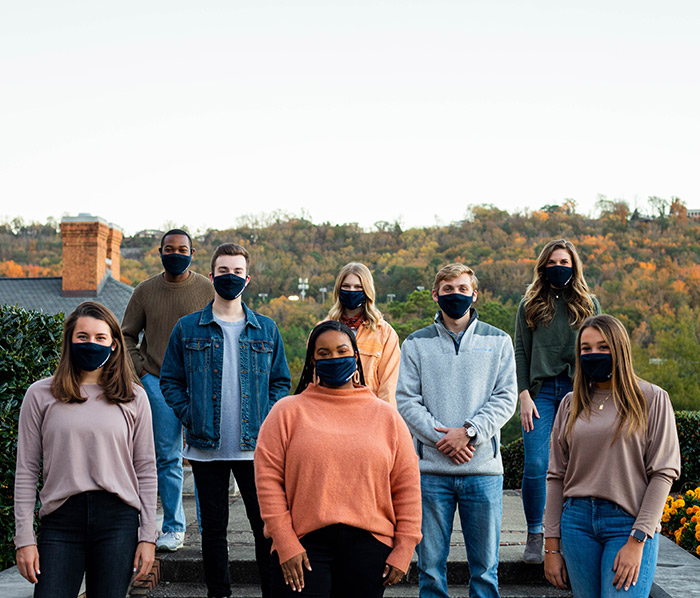
It has been more than a year since the COVID-19 pandemic changed the way people live, work and learn. During that time, Samford has undertaken extensive planning and innovative approaches in response to the global crisis.
Robust and Multi-tiered Testing
The university’s extensive ongoing pandemic response efforts include: health and safety training, the establishment of spaces and protocols for quarantine and isolation, thorough testing, an extensive process of contact tracing and vaccination opportunities.
Through a robust testing program, Samford worked tirelessly to prevent the spread of COVID-19. The program has achieved its two primary goals: prevent cases from arriving on campus and early identification of positive cases before they spread to other parts of the campus. For instance, in the fall semester, focus testing identified 37 positive cases in one organization before they could spread anywhere else. In January alone, Samford prevented more than 300 positive cases from arriving on campus through the re-entry testing program. Since then, Samford’s COVID-19 dashboard reported an average of only a few cases per week.
“We’ve invested a great deal of resources to provide what we’ve been told is the most robust, multi-tiered testing program in the state,” said Colin Coyne, chief strategy officer at Samford. “The success of the program, however, rests on three pillars: first, developing trust that the program is fair, equitable and consistent; second, seeing students foremost as the solution, not the problem; and third, the patience and grace of everyone in the community: students, employees, parents, and trustees. As inconvenient as testing can be, it’s been the lynchpin of our ability to do more than we imagined possible last summer.”
Overall, since August 2020, Samford has administered more than 36,000 tests, including return-to-campus testing, sentinel testing, focus testing and on-demand testing.
More recently, thanks to a partnership with state officials and the University of Alabama at Birmingham, Samford was able to offer vaccination opportunities for every full-time and part-time employee. Currently, more than 86% of full-time employees report being vaccinated, with 74% facilitated by Samford.
As a result of Samford’s aggressive approach to preventing the spread of COVID-19, positive cases on campus have remained below state and national trends. In fact, as illustrated in the university’s COVID-19 dashboard, over the past six weeks, Samford’s sentinel testing reveals a positivity rate of only 0.2% over 4,477 tests.
New Opportunities for Student Learning
When the COVID-19 vaccine arrived in Alabama, Moffett & Sanders School of Nursing students and faculty were among the first to administer doses to frontline health care workers at local Birmingham hospitals. In December, upper-level nursing students staffed clinics at St. Vincent’s Birmingham and St. Vincent’s East, while lower-level students served in a variety of non-clinical roles.
“Our students are gaining real-life experience working with an interprofessional team, administering vaccines, reviewing health histories, providing teaching to vaccine recipients and monitoring recipients for adverse effects of the vaccine,” said Cindy Berry, professor and clinical education and community partnerships director. “This is a once-in-a-lifetime learning experience but also an opportunity for our students to serve a health care community who have been through so much this past year.”
More recently, Samford’s vision for interprofessional education shifted to real-world implementation when the university conducted its first on-campus COVID-19 vaccination clinic on March 26. Led by the nursing, pharmacy and public health schools, 33 students and four faculty volunteers teamed with residence life, public safety and business services to administer the Pfizer SARS-CoV-2 vaccine to employees and at-risk students following guidelines established by the Alabama Department of Public Health (ADPH). The vaccination clinic was made possible through an affiliation with Encompass Health Lakeshore.
The university is planning another 400-dose clinic on April 30, following guidelines for vaccine recipients as stipulated by the ADPH. Looking ahead, Samford continues to pursue vaccination opportunities for all Samford students as ADPH guidelines allow.
Planning and Perseverence
Over the summer months, the university utilized a collaborative process for making important decisions about operations with representatives from across campus and throughout the community working together to develop comprehensive plans to campus protocols.
Two groups were formed to facilitate planning—the Pandemic Response Team and the Continuity of Instruction Task Force. These two groups were critical in developing instructional and operational strategies to form the university’s comprehensive plan for the 2020-21 academic year.
The university adapted quickly and developed innovative, engaging ways to share the Samford experience with prospective, incoming and returning students. Samford’s faculty and leadership found ways to persevere, preserving the student experience and maintaining a focus on its mission to nurture the development of intellect, creativity and faith. As a result, throughout the fall semester, most course work across undergraduate and graduate degree programs continued to be taught in either face-to-face or hybrid formats in order to maximize the number of in-person learning experiences.
“Through hard work, a collegial spirit and the focus always on students, Samford faculty found ways to persevere through an academic year like no other, renewing their commitment to creativity, innovation and collaboration. The lessons we learned and the technology we utilized are enabling us to make the student learning experience even better,” said Mike Hardin, provost of Samford University.
Perhaps even more impressively, despite the challenges presented by the pandemic and a decrease in enrollment at institutions across the country, Samford experienced its 12th consecutive year of record enrollment, as well as a student retention rate of 94.5% between the fall and spring semesters.
Looking ahead, Samford recently announced plans for in-person commencement activities this spring, and normal operations and instruction this fall.
